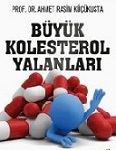THREE REASONS TO ABANDON LOW-DENSİTY LİPOPROTEİN TARGETS

- Editor’s Perspective
Three Reasons to Abandon Low-Density Lipoprotein Targets
An Open Letter to the Adult Treatment Panel IV of the National Institutes of Health
- Rodney A. Hayward, MD and
- Harlan M. Krumholz, MD, SM
+ Author Affiliations
From the Department of Internal Medicine and the Robert Wood Johnson Clinical Scholars Program, University of Michigan; Department of Veterans Affairs, VA HSR&D Center of Excellence, VA Ann Arbor Healthcare System, Ann Arbor, MI (R.A.H.); and Section of Cardiovascular Medicine and the Robert Wood Johnson Clinical Scholars Program, Department of Medicine, Yale School of Medicine; Section of Health Policy and Administration, Yale School of Public Health; Center for Outcomes Research and Evaluation, Yale–New Haven Hospital, New Haven, CT (H.M.K.).
Key Words:
Next Section
Introduction
The updated clinical guidelines for cholesterol testing and management (Adult Treatment Panel (ATP) IV) from the Expert Panel on Detection, Evaluation, and Treatment of High Blood Cholesterol in Adults are under development and due to be published in 2012. These influential guidelines are organized and funded by the National Heart, Lung, and Blood Institute (NHLBI) and carry the imprimatur of the federal government. In this iteration, the NHLBI has a stated goal of integrating its set of Cardiovascular Risk Reduction guidelines.1
A primary focus of the previous version of the guidelines, ATP III, was a strategy of treating patients to target low-density lipoprotein (LDL) cholesterol levels. ATP III stated that “recent clinical trials robustly show that LDL-lowering therapy reduces risk for CHD. For these reasons, ATP III continues to identify elevated LDL cholesterol as the primary target of cholesterol-lowering therapy. As a result, the primary goals of therapy and the cutpoints for initiating treatment are stated in terms of LDL.” This reasoning, however, diverged from the clinical evidence, recommending an approach that was not tested in any clinical trial.
Outcomes research promotes the need to demonstrate benefit before making recommendations for medical intervention.2,3 In that spirit, we present an open letter to the ATP IV Committee that provides the rationale for why the new guidelines should abandon the treat-to-target paradigm.
Dear ATP IV Committee,
We are writing to encourage you to abandon the paradigm of treating patients to LDL targets, a change that will better align ATP IV with current clinical evidence. Changing long-held beliefs is never easy, even when the need for change is based on strong evidence. Change is especially difficult when prior beliefs are firmly embedded in culture, accepted as dogma, and codified in books, articles, guidelines, public service announcements, and performance measures. Still, what is most important is that guideline committees follow a process that adheres closely to the scientific evidence, particularly the details of the clinical trials—which are abundant for lipid treatment.
The evidence supports moving away from a target-based approach, a step that could launch a new era of guidelines in which treatment targets are replaced by a more tailored treatment approach (sometimes referred to as “individualized” or “personalized” care), which can improve patient outcomes while reducing harms and costs caused by overtreating low-risk/low-benefit individuals.4–8
Below, we present briefly the primary reasons that justify a major change in the next generation of ATP guidelines.
There Is No Scientific Basis to Support Treating to LDL Targets
First, no major randomized clinical trial (RCT) has tested the benefits of treating patients according to LDL targets.5 The clinical trials tested fixed doses of drugs that lower lipid levels in specific patient populations. In some of these trials, drugs were shown to reduce risk (eg, statins), but in others, this reduction in risk was not demonstrated (eg, clofibrate and torcetrapib). Other drugs, such as ezetimibe, remain to be tested. The trials do not demonstrate that all drugs that reduce lipid levels reduce patient risk. Thus, the dogma that treating to target is based on clinical trial evidence belies the fact that no clinical trial has yet tested this strategy.
Tamamını okumak için: http://circoutcomes.ahajournals.org/content/5/1/2.full

















Amerikada ne varsa burada da var. Boşuna dememişler “Türkiye küçük Amerika olacak” diye